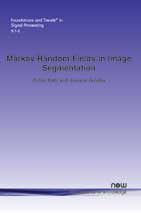Markov Random Fields in Image Segmentation
By Zoltan Kato, Image Processing and Computer Graphics Dept., University of Szeged, Hungary, kato@inf.u-szeged.hu | Josiane Zerubia, INRIA Sophia Antipolis-Mediterranee, France, Josiane.Zerubia@inria.fr
Abstract
This monograph gives an introduction to the fundamentals of Markovian modeling in image segmentation as well as a brief overview of recent advances in the field. Segmentation is considered in a common framework, called image labeling, where the problem is reduced to assigning labels to pixels. In a probabilistic approach, label dependencies are modeled by Markov random fields (MRF) and an optimal labeling is determined by Bayesian estimation, in particular maximum a posteriori (MAP) estimation. The main advantage of MRF models is that prior information can be imposed locally through clique potentials. The primary goal is to demonstrate the basic steps to construct an easily applicable MRF segmentation model and further develop its multiscale and hierarchical implementations as well as their combination in a multilayer model. MRF models usually yield a non-convex energy function. The minimization of this function is crucial in order to find the most likely segmentation according to the MRF model. Besides classical optimization algorithms, like simulated annealing or deterministic relaxation, we also present recently introduced graph cut-based algorithms. We briefly discuss the possible parallelization techniques of simulated annealing, which allows efficient implementation on, e.g., GPU hardware without compromising convergence properties of the algorithms. While the main focus of this monograph is on generic model construction and related energy minimization methods, many sample applications are also presented to demonstrate the applicability of these models in real life problems such as remote sensing, biomedical imaging, change detection, and color- and motion-based segmentation. In real-life applications, parameter estimation is an important issue when implementing completely data-driven algorithms. Therefore some basic procedures, such as expectation-maximization, are also presented in the context of color image segmentation.
Markov Random Fields in Image Segmentation
Markov Random Fields in Image Segmentation introduces the fundamentals of Markovian modeling in image segmentation as well as providing a brief overview of recent advances in the field. Segmentation is considered in a common framework, called image labeling, where the problem is reduced to assigning labels to pixels. In a probabilistic approach, label dependencies are modeled by Markov random fields (MRF) and an optimal labeling is determined by Bayesian estimation, in particular maximum a posteriori (MAP) estimation. The main advantage of MRF models is that prior information can be imposed locally through clique potentials. The primary goal is to demonstrate the basic steps to construct an easily applicable MRF segmentation model and further develop its multiscale and hierarchical implementations as well as their combination in a multilayer model. MRF models usually yield a non-convex energy function. The minimization of this function is crucial in order to find the most likely segmentation according to the MRF model. Besides classical optimization algorithms like simulated annealing or deterministic relaxation, this book also presents recently introduced graph cut-based algorithms. It discusses the possible parallelization techniques of simulated annealing, which allows efficient implementation on, for example, GPU hardware without compromising convergence properties of the algorithms. While the main focus of this monograph is on generic model construction and related energy minimization methods, many sample applications are also presented to demonstrate the applicability of these models in real life problems such as remote sensing, biomedical imaging, change detection, and color- and motion-based segmentation. In real-life applications, parameter estimation is an important issue when implementing completely data-driven algorithms. Therefore some basic procedures, such as expectation-maximization, are also presented in the context of color image segmentation. Markov Random Fields in Image Segmentation is an essential companion for students, researchers and practitioners working on, or about to embark on research in statistical image segmentation.

Sample implementation of algorithms in grey scale | 2000000035_MRFdemo.zip (ZIP).
Software for "Markov Random Fields in Image Segmentation" By Zoltan Kato and Josiane Zerubia
DOI: 10.1561/2000000035_demogray
Sample implementation of algorithms in color | 2000000035_ColorMRFdemo.zip (ZIP).
Software for "Markov Random Fields in Image Segmentation" By Zoltan Kato and Josiane Zerubia